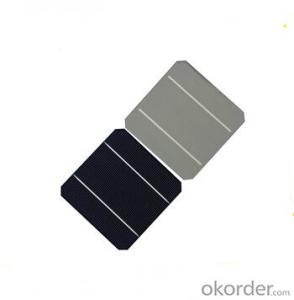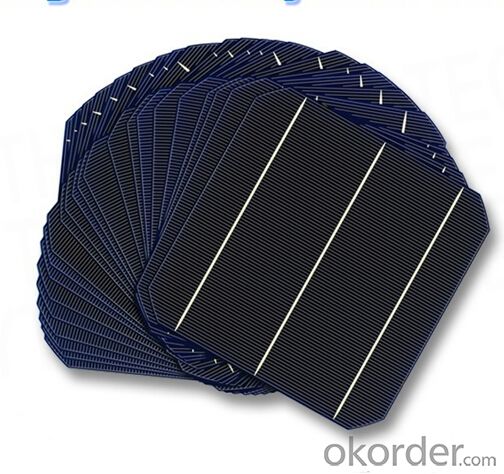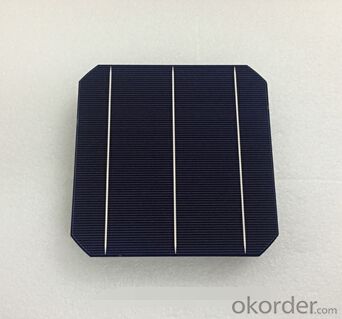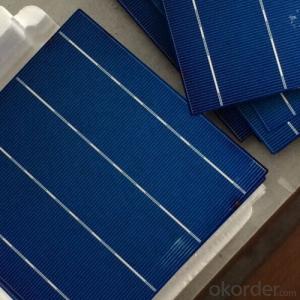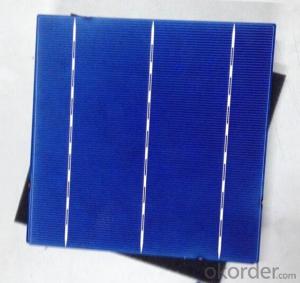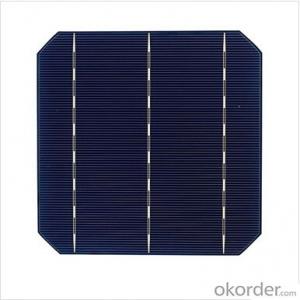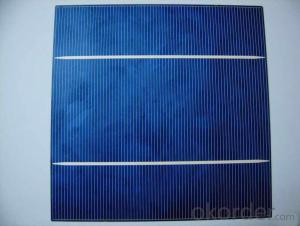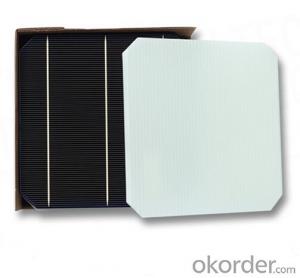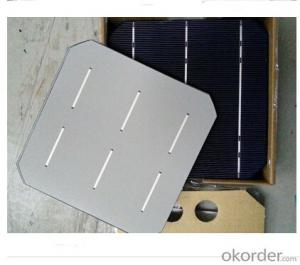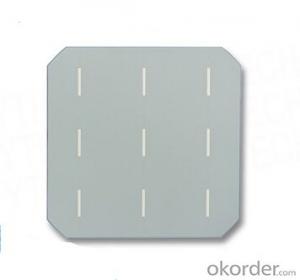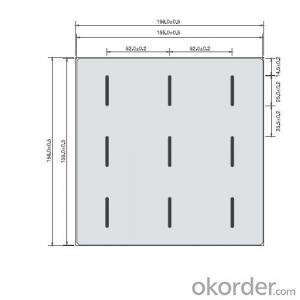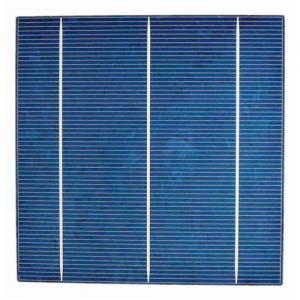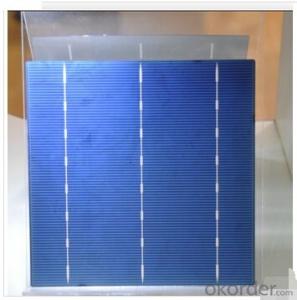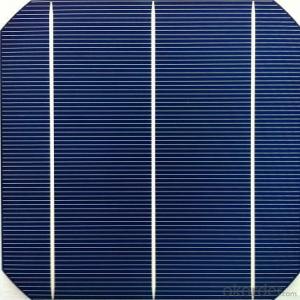More Efficient A-Grade 17.2% Monocrystalline Solar Cells
- Loading Port:
- Shanghai
- Payment Terms:
- TT OR LC
- Min Order Qty:
- 5000 pc
- Supply Capability:
- 8000000 pc/month
OKorder Service Pledge
OKorder Financial Service
You Might Also Like
Monocrystalline Solar Cells A GRADE
Solar cells is made by solar wafer, it has three categories of solar cell right now, monocrystalline polycrystalline and thin film,These cells are entirely based around the concept of ap-n junction, which is the critical part of solar module, it is the part that can convert the light energy into electricity, the thickness is from 180um to 200um, with even busbars to conduct electricity, textured cell can decrease diffuse reflection; they are often electrically connected and encapsulated as a module. Photovoltaic modules often have a sheet of glass on the front (sun up) side, allowing light to pass while protecting semiconductor wafers from abrasion and impact due to wind-driven debris, rain, hail, etc. Solar cells are also usually connected in series in modules, creating an additive voltage. Connecting cells in parallel will yield a higher current;With high quality and stable quality. Our Cells can greatly improve the performance of Solar Modules.
Advantage of Monocrystalline Solar Cells
• High efficiency and stable performance in photovoltaic conversion.
• Advanced diffusion technique ensuring the homogeneity of energy conversion efficiency of the cell.
• Advanced PECVD film forming, providing a dark blue silicon nitride anti-reflection film of homogenous color and attractive appearance.
• High quality metal paste for back surface and electrode, ensuring good conductivity, high pulling strength and ease of soldering.
• High precision patterning using screen printing, ensuring accurate busbar location for ease with automatic soldering a laser cutting.
Specification:
Efficiency (%) Pmpp (W) Umpp (V) Impp (A) Uoc (V) Isc (A) |
18.20% 4.43 0.536 8.263 0.634 8.712 |
18.00% 4.38 0.535 - 8.188 0.633 8.701 |
17.80% - 4.33 0.534 - -8.112 ---0.632 ----8.652 |
17.60% 4.28 0.533 8.036 0.631 8.641 |
17.40% 4.23 0.529 8.005 0.630 8.591 |
17.20% 4.19 0.525 7.973 0.627 8.542 |
17.00% 4.14 0.522 7.926 0.624 8.495 |
16.80% 4.09 0.518 7.893 0.620 8.452 |
16.60% 4.04 0.515 7.844 0.617 8.410 |
16.40% 3.99 0.514 7.765 0.616 8.373 |
16.20% 3.94 0.511 7.715 0.615 8.317 |
16.00% 3.89 0.509 7.650 0.613 8.251 |
Photovoltaic cell, also known as PV or solar cell, is created from semiconductor material such as silicon. The process of solar conversion is as below:
1) when light strikes the cells, a specific portion or "band" of the light wave is absorbed by the material;
2) that solar energy causes the semiconductor material to release electrons;
3)the semiconductor material is positioned within an electrical field by using negatively or positively charged silicon(n-type and p-type), so that all electrons set "free" from the material are forced to flow-generating electrical current.
Applications of Monocrystalline Solar Cells
Assemblies of photovoltaic cells are used to make solar modules which generate electrical power from sunlight, as distinguished from a "solar module" or "solar panel". A solar array generates solar power using solar energy.
Packaging & Delivery of Monocrystalline Solar Cells
Carton Box Package and Deliver by air. It should be noticed that it should be avoid of water, sunshine and moist.
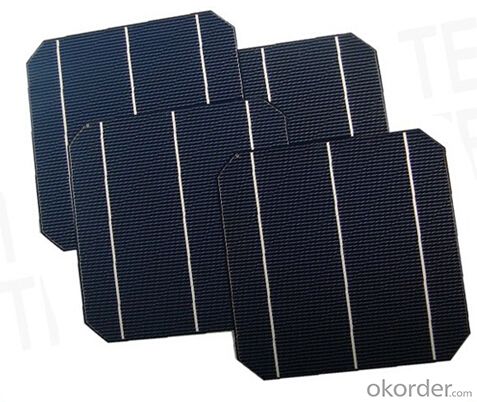
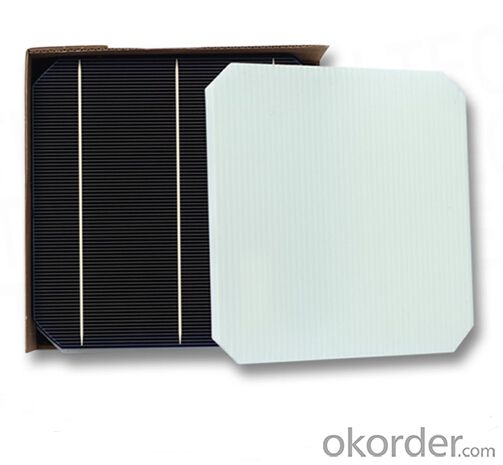
FAQ
We have organized several common questions for our clients,may help you sincerely:
1. What’s price per watt?
A: It’s depends on the quantity, delivery date and payment terms of the order. We can talk further about the detail price issue. Our products is high quality with lower price level.
2. Can you tell me the parameter of your solar cells?
We have different series of cells with different power output, both from c-si to a-si. Please take our specification sheet for your reference.
3. How do you pack your products?
We have rich experience on how to pack the panels to make sure the safety on shipment when it arrives at the destination.
4. Can you do OEM for us?
Yes, we can.
5. How long can we receive the product after purchase?
In the purchase of product within three working days, We will arrange the factory delivery as soon as possible. The perfect time of receiving is related to the state and position of customers. Commonly 7 to 10 working days can be served.
- Q: How do solar cells perform in regions with frequent thunderstorms?
- Solar cells perform less efficiently in regions with frequent thunderstorms. Thunderstorms often bring heavy cloud cover and reduced sunlight, which significantly impacts the generation of solar energy. Additionally, the presence of lightning poses a risk to the solar panels themselves, potentially damaging or destroying them. Therefore, regions with frequent thunderstorms may not be ideal for solar energy production.
- Q: What are the advantages of using solar cells?
- The advantages of using solar cells include renewable and sustainable energy generation, reduced greenhouse gas emissions, lower energy costs in the long run, and increased energy independence. Solar cells also require minimal maintenance and have a long lifespan, making them a reliable and durable energy solution.
- Q: What is the impact of shadows on solar cell performance?
- Shadows have a negative impact on solar cell performance as they reduce the amount of sunlight reaching the cells, thereby decreasing their efficiency in converting sunlight into electricity. Shadows can create hotspots on the cells, leading to potential damage and reduced lifespan. It is crucial to ensure that solar panels are installed in areas with minimal shading to maximize their performance and energy generation.
- Q: PV: the battery to the battery charge problem
- I use the BUCK circuit, controlled by the microcontroller, the circuit is not too difficult, are ready, but the understanding of BUCK problems. See a lot of books are written on the battery can be constant pressure charging, feeling can not understand. Now I think they are probably wrong, the voltage across the battery in the BUCK circuit is out of control.
- Q: What is the effect of pollution on solar cell performance?
- Pollution has a significant negative effect on solar cell performance. Air pollution, such as smog and particulate matter, reduces the amount of sunlight reaching the solar cells, thereby reducing their efficiency. Additionally, pollutants like dust and dirt can accumulate on the surface of the solar panels, further decreasing their performance. Overall, pollution hampers the ability of solar cells to generate electricity effectively, highlighting the importance of clean environments for optimal solar energy production.
- Q: Can solar cells be used on backpacks or camping gear?
- Yes, solar cells can be used on backpacks or camping gear. These portable solar panels can harness sunlight and convert it into electricity to charge devices such as smartphones, GPS devices, or even power small appliances while on the go. They are lightweight, durable, and designed for outdoor use, making them a convenient and eco-friendly power source for outdoor enthusiasts.
- Q: Can solar cells be used in urban areas?
- Yes, solar cells can be used in urban areas. In fact, they are increasingly being utilized in cities to harness solar energy and reduce dependence on traditional power sources. Solar cells can be installed on rooftops, facades, and other available spaces, enabling urban areas to generate clean, renewable energy locally.
- Q: What is the role of tracking systems in solar cell installations?
- The role of tracking systems in solar cell installations is to optimize the amount of sunlight that reaches the solar panels throughout the day. These systems continuously monitor the position of the sun and adjust the orientation and tilt of the panels accordingly. By tracking the sun's movement, the panels can capture more sunlight and generate higher energy output, increasing the overall efficiency of the solar cell installation.
- Q: Can solar cells be used in power plants?
- Yes, solar cells can be used in power plants. Solar power plants, also known as solar farms or solar parks, use large arrays of solar panels or solar cells to convert sunlight into electricity on a larger scale. These power plants capture and harness solar energy to generate electricity, making them a sustainable and renewable energy source.
- Q: How do solar cells affect the environment?
- Solar cells have a positive impact on the environment. They produce clean, renewable energy by converting sunlight into electricity, reducing the reliance on fossil fuels. Solar cells emit no greenhouse gases or air pollutants during operation, helping to combat climate change and improve air quality. Additionally, they have a minimal impact on water resources and land use compared to other energy sources.
Send your message to us
More Efficient A-Grade 17.2% Monocrystalline Solar Cells
- Loading Port:
- Shanghai
- Payment Terms:
- TT OR LC
- Min Order Qty:
- 5000 pc
- Supply Capability:
- 8000000 pc/month
OKorder Service Pledge
OKorder Financial Service
Similar products
Hot products
Hot Searches
Related keywords
